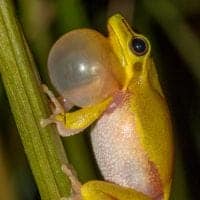
An amphibian is a type of cold-blooded vertebrate that belongs to the class Amphibia. These creatures are famous for their life-on-the-edge lifestyle, straddling both aquatic and terrestrial worlds.
Here are the 3 different types of amphibians in the animal kingdom:
Types of Amphibians
Amphibians, those slippery, cold-blooded critters that keep one foot in the water and the other on land, mainly fall into three diverse groups. Let’s dive in!

Frogs and Toads (Order: Anura)
These jumpers are the most vocal and perhaps the most familiar amphibians out there. Frogs are the sleek, moist ones; toads are their warty, dry-skinned cousins. Despite their differences, they share a love for a good leap and a life cycle that morphs from water-bound tadpole to land-hopping adult. Explore what do frogs eat and toads’ diet here.

Salamanders and Newts (Order: Caudata)
These creatures are the undercover agents of the amphibian world. Sporting long bodies and tails, they’re more secretive, often found under logs or stones. Salamanders keep their skin moist and breathe through it, while newts are a type of salamander with a knack for living both in water and on land, changing their wardrobe (skin texture and color) as they move between the two. Explore what do salamanders eat here.

Caecilians (Order: Gymnophiona)
The mystery guests of the amphibian party, caecilians are legless and often mistaken for snakes or worms. These secretive, soil-dwelling creatures are the least known, spending much of their lives hidden away underground or in streambeds. They’re fascinating in their own right, with a unique set of sensory tentacles between their eyes and nostrils to help them navigate their murky world.
Key Features of Amphibians

Dual Life Cycle
Amphibians lead a double life, starting in water as larvae with gills, then often moving to land as adults with lungs.

Moist, Permeable Skin
Their skin is not just a covering but a vital respiratory organ, allowing them to absorb oxygen and water directly from their environment.

Cold-Blooded (Ectothermic)
Amphibians rely on external sources to regulate their body temperature, making them highly sensitive to environmental changes.

Egg-laying in Water
Their jelly-like eggs are laid in water or moist places, hatching into larvae that live in water until they metamorphose into land-dwelling adults.

Metamorphosis
This dramatic transformation from larva to adult involves significant changes in form and habitat, from gill-breathing to lung-breathing, among other adaptations.

Varied Breeding Calls
Especially in frogs and toads, males serenade females with unique calls to attract them for mating—a cacophony of nature’s music.

Environmental Indicators
Their permeable skin and dual habitats make amphibians excellent indicators of ecological health, signaling changes in the environment.

Breathing Skin
Universal among amphibians, their skin facilitates gas exchange, supplementing their respiratory system and keeping them tied to moist environments.

Lethal Defense (in some species)
While not universal, certain amphibians (frogs) boast potent toxins as a defense mechanism, deterring predators with their chemical arsenal.











